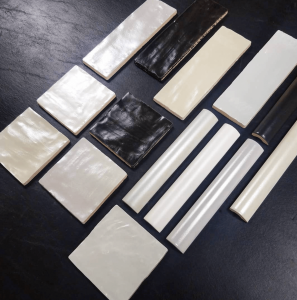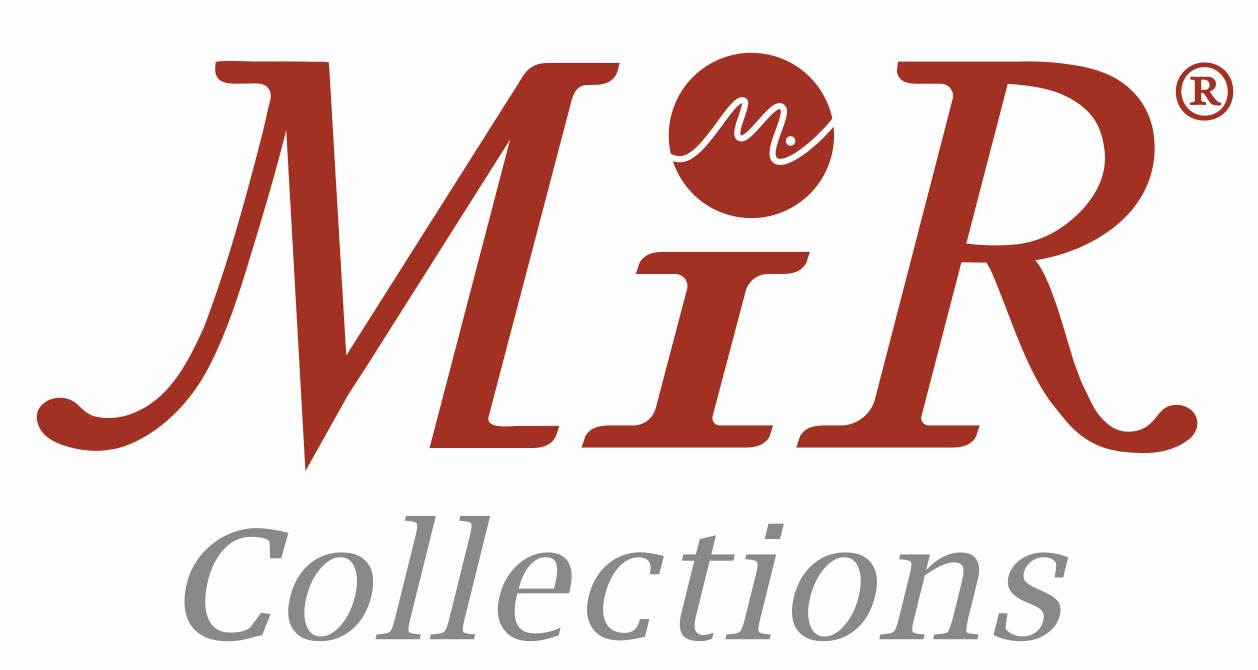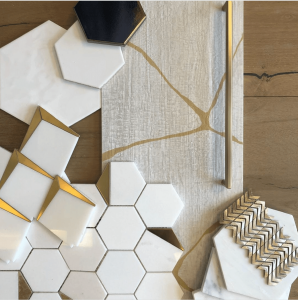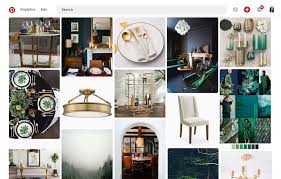A Guide To Creating An Interior Design Moodboard
Luxury bathroom moodboard featuring herringbone gold mosaic tiles for a feature wall, gold and white arrowhead tile (Angolo 3) for a backsplash and hexagon tiles for shower walls/floors.
Whether you’re a seasoned pro or just starting out in the interior design world, you are likely familiar with the importance of mood boards. They are beautiful visualizations of a design to come; showcasing textures, materials, and patterns all in a birds-eye view. Maybe, you’ve created many of these beautiful interior design collages before, or you’re here to learn how to! In either case, we have you covered. Below you’ll be armed with the knowledge about moodboards from use cases to the creation of one all the way down to some inspiration for your next one. Ready to dive in and get ready for some serious eye candy? Scroll on down.
What is an Interior Design Moodboard?
Moodboards, in the most literal sense, are like vision boards for your interior design project. They should tell a story or weave together a common theme that presents your core ideas in the form of images, colors, materials and text. The success of a moodboard lies in its ability to provide an at-a-glance understanding of the interior design style or concept you have in store for your project.
Beautiful white and gold moodboard featuring white and gold mosaic tile (Angolo 3) with customer’s lifestyle in mind.
While creating a moodboard, it’s necessary to place all your ideas together to see how they can eventually work in a given design (be it a bathroom remodel or total home renovation.) You’ll want to lay out the specific furniture pieces you’re considering, textiles you’d like to incorporate, specific paint colors, floor tiles and wall tiles, as well as any existing pieces in the space that will carry on in the design.
A moodboard, then, is a jumping off point for you to share ideas with your clients in a more digestible way. The importance of the moodboard is how it plays a role in showcasing your interior design ideas before implementation of any sort so that everyone is on the same page.
To give even more emphasis on the importance, here are 3 key reasons to design with moodboards:
Helps the client visualize your ideas. Firstly, interior design moodboards will save you headaches down the line and alleviate any differences in design tastes for your clients. Clients hire you to design their space since they need direction and guidance for creative design. As such, these design collages provide them with that and helps to bridge the gap between where they are and where you will take them.
Manages the client expectation. Rather than diving in post-conversation and ordering everything that you feel is needed for an interior design or remodel project, this helps give a clear definition of what the client can expect in their final reveal. There are less chances at surprises; For example, if you present a coastal moodboard and the client wants something more luxurious, this gets fixed right away with minimal cost involved.
Keeps things organized. Aside from making client communication go more smoothly, moodboards also allow for a degree of organization. For example, you can house everything you plan to buy, use, or decorate with in one spot for easy reference as you go about the project.
How To Create a Moodboard 
A moodboard design that can make any space the object of envy featuring green glass mosaic tiles (Mondrian Emerald) and green furnishings.
Now that you have a handle on what a moodboard is and why it is so vital to a project’s success, allow us to walk you through a step-by-step process in creating one!
Gather Images
This may seem like a no-brainer, but you’d be surprised how easy it is to mix things up! The first step is to gather all images with a cohesive feeling. You don’t want to save just anything that strikes your fancy, you want to be strategic. Keep in mind color scheme, budget and room of design. Peruse design blogs, Pinterest, and Instagram to get endless inspiration and a clear idea of what you want to add. Then, save them out!
Add In Any Must-Keeps
All right, so now you have a ton of inspirational, pretty images lined up and ready to use! Amazing. The next thing you have to do is consider the client’s space and anything that they label a must-keep. This could be existing flooring, a backsplash tile, a dining room table or lighting, for instance. Be sure to find similar images (or ask them to send the names of the pieces so you can grab identical ones) and add these into your concept.
Begin to Stitch It Together
Once you have all the core elements of the design, it’s time for the fun part; creating the moodboard itself! To do so, you’ll want to place pieces that will work off one another together in the college. For example, place fabric swatches next to the tile selection you choose to see how the colors play off one another or place the accent rug next to the bathroom vanity for good measure. The goal is to make a seamless design story that can later act as a mock-up guide.
Quick Tip:
When you’re choosing tile for a design, it’s a great idea to order samples of any images you save out. It’s the best way to be able to really feel, see and evaluate the texture and the color of the piece. This will help bring your moodboard to life later on when presenting to a client and alleviate any possible disconnect between interior design plan and design outcome.
Methods To Create An Interior Design Moodboard
Interior designer building out a moodboard with our Siwa Tile for a nautical room. (BluPearlCo)
Let’s dive into the different ways you can setup your moodboard and the applications available!
Free, and a forever industry favorite, Pinterest is a seamless way to get a moodboard going. The ability to make dedicated boards for each client project and set them to private gives you ample ability to gather your design ideas in a streamlined way. You can pin from other boards, from websites, or from your own blog to get ideas in a cohesive way and make a beautiful digital moodboard.
Canva
A mostly free platform, but you can upgrade to a paid version for more options. Canva allows you to create a collage from already-made templates. This is an ideal setup for those that are just starting out with moodboard creation and want to be able to gather images across sources (from their own phone to Pinterest) and place them together in an aesthetically pleasing way. Plus, you have the option to download your moodboard or share a link to it with clients. Easy peasy.
Millanote

A more tech-savvy option, this is described as Evernote for design. You can import images from multiple sources, similar to Canva, but also seamlessly add in text clippings and style your project on a fully blank canvas. This program will cost you $10/month to use though.
Impact of Moodboard on Interior Design
By now, you’re probably ready for some inspiration, right?! At least, we know we usually are. Well, buckle up, we’re giving you a few of our top moodboard implementations to showcase how they take you from thought to creation.
Coastal Blues Small Kitchen Tile Moodboard 
Design By: BluPearlCo
Finding tranquility comes easy when first laid out in a moodboard! Case-in-point in this coastal chic theme design by Blu Pearl Co. Featuring our Paraga square mosaic tile, it becomes easy to see the aesthetic for the interior designer’s plan taking shape. Using a mix of materials for what will ultimately be a small space kitchen, the storyline is cohesive, even at a very basic level. From this, you get a sense of the wall tile or backsplash tile to be used, the kitchen flooring, the lighting and the color scheme.
Design By: BluPearlCo
See? The design outlined above showcases how important an interior design moodboard is in setting the stage for a design. The team took the materials and transposed them into a stunning, coastal chic kitchen design with a blue and white mosaic backsplash tile that stuns. Tying together the kitchen tile design with a white countertop, stainless steel stove, light blue cabinetry and a rustic wood floor, the kitchen is cozy and bright.
Covetable Contrasts Kitchen Tile Moodboard

Sometimes, it’s best to start a moodboard off with basics; by defining which wall tile, floor tile or accent tile you’ll be using in a space. That’s exactly what this material-focused moodboard did. The designers took stock of various hues of zellige ceramic tiles to assess what would ultimately work in their modern kitchen design. Wanting the space to have a clean, industrial feeling with a textural imprint, the use of square ceramic tiles or subway ceramic tiles seemed fitting.

Ultimately, the decision led to this urban industrial kitchen design! With a focus on clean lines, and touches of metal, the space is bold and enticing. The ceramic backsplash tile and feature wall tile adds a unique twist to the design; bringing in a more organic ambiance to the otherwise cold palette. The contrast between white tile and black tile makes for an undeniably eye-catching look that chefs and guests combined will swoon over!
Elegant Touch Bathrooom Tile Moodboard

By: TiledInteriors
So many chic white marble tiles, so little time. At least, that’s the storyline that this excruciatingly beautiful moodboard gives off! When met with designing an upscale, Hollywood glam inspired kitchen, designers needed to figure out how to bring in the right statement tile for the job. Should they use a marble and pearl tile or a floral marble tile? Seeing all options in a tile moodboard helped to assess inventory before translating it into an overarching moodboard with fixtures.

Ultimately, the deciding factor was how to make the tile stand out in the overall kitchen design. Keeping that in mind, the interior designer’s went with the Coastal Surge white marble tile that has bits of pearl to create a jewelry box design that wows. The combination calacatta gold marble, Thassos marble and shell tile proved just right to foster a glamorous environment for clients and guests alike.
Pattern Tile & Plant Fusion Moodboard

By: Best Tile
With the goal to make sleek, modern kitchen, the designers who created this moodboard added different statement tiles, classic penny tiles and gray tones together. By adding plants to the interior, it was a way to add a fusion of nature into the space while giving a pop of color.

The final result? An impactful, expansive modern kitchen that has all the gray tones initially laid out, but with a slightly more pulled together aesthetic. Seen in the final design is the gray geometric marble backsplash tile, providing depth and visual interest, as well as the gray textile bar chairs and metallic pendant lighting. The addition of plants and fruits give a much-needed addition of color that makes it livable, and vibrant.
Asian Zen Bathroom Moodboard

By: Palm Tile
Taking inspiration from the beauty of cherry blossoms, the designer’s goal was to create an Asian inspired bathroom with organic touches. Bringing in blue as the main color and working it through the rest of the design; from mosaic tiles for the shower to hints of blue in floral porcelain floor tiles (Kasai Carta Sakura), this design board creates a hint of the sanctuary to come.

The outcome magnifies the original beauty envisioned for this master bathroom. With the floral pattern porcelain tiles adorning the floor, there’s a sweetness to the overall space that is both serene and modern. Adding to the zen aesthetic is the beautiful blue penny round tiles on the shower floor with blue glass mosaic tiles in the shower niche. Sound, earthly and beautifying, just as anticipated.
Want to get inspired even further? Explore all our beautiful designs on our Instagram account @mir.mosaic! We bring beautiful design inspiration to you daily so you’re never out of ideas.
Share The Inspiration – Pin The Post!









